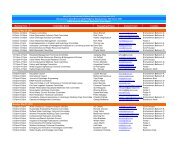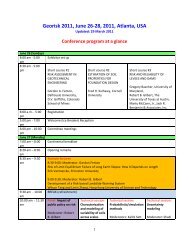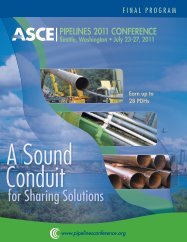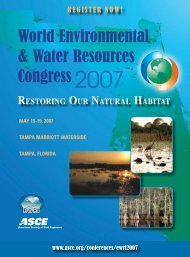August 1-4, 2010 - American Society of Civil Engineers
August 1-4, 2010 - American Society of Civil Engineers
August 1-4, 2010 - American Society of Civil Engineers
Create successful ePaper yourself
Turn your PDF publications into a flip-book with our unique Google optimized e-Paper software.
4<br />
<strong>2010</strong><br />
Short Course #1: Geosynthetic Reinforced Soil<br />
Instructors:<br />
Robert D. Holtz, PhD, PE, D.GE, Dist. M.ASCE<br />
University <strong>of</strong> Washington<br />
R. Jonathan Fannin, Ph.D., P. Eng.<br />
University <strong>of</strong> British Columbia<br />
Short Courses<br />
Sunday, <strong>August</strong> 1 8:30am - 5pm, Course Fee: $295/course<br />
This course is an advanced treatment <strong>of</strong> geosynthetics for soil<br />
reinforcement. Because <strong>of</strong> their increased safety, improved performance,<br />
and lower costs in comparison with conventional construction,<br />
geosynthetic reinforced soil (GRS) structures are <strong>of</strong>ten used instead <strong>of</strong><br />
conventional earth retaining structures, bridge abutments, and fi ll slopes.<br />
The participants should have some experience with geosynthetics<br />
and conventional reinforced soil design and construction. After a brief<br />
introduction to geosynthetics, the material properties required for design<br />
(tensile strength, including wide-width index tests and isochronous loadstrain<br />
tests; soil-geosynthetic interface strength and bond coeffi cients<br />
from direct shear and pullout tests; durability issues) are described.<br />
Two instrumented reinforced soil case studies are used to show that<br />
the sensible application <strong>of</strong> simple ideas and methods can give safe and<br />
acceptable engineering solutions to reinforced soil problems. These<br />
basic ideas are suffi ciently adaptable for the design and successful<br />
construction <strong>of</strong> more complex problems <strong>of</strong>ten found in engineering<br />
practice.<br />
Course Outcomes<br />
» Develop an understanding <strong>of</strong> the fundamental concepts that govern the behavior <strong>of</strong><br />
soils reinforced with geosynthetics.<br />
» Understand the historical development <strong>of</strong> the analyses for external and internal<br />
stability (FHWA, AASHTO, NCMA, BS 8006), and provide design guidance for allowable<br />
tensile strength, vertical reinforcement spacing, length <strong>of</strong> reinforcement, drainage,<br />
seismic loading issues, and different facing systems.<br />
» Provide the basis for confi dently making and defending appropriate decisions when<br />
designing geosynthetic-reinforced steep slopes and walls.<br />
<strong>August</strong> 1-4, <strong>2010</strong> | Hyatt Regency Bellevue, Bellevue, Washington<br />
Short course #2: Earth Retaining Systems and<br />
Basement Walls<br />
Instructors:<br />
Nick O’Riordan, Ph.D.<br />
Principal and Global Geotechnics Skills Leader, Arup (San Francisco)<br />
Richard Prust<br />
Associate Principal, Arup (Seattle)<br />
Rob Talby, Ph.D.<br />
Associate, Arup (New York)<br />
Pressure on urban development, downtown regeneration and in particular<br />
the growth <strong>of</strong> underground metro and heavy rail systems has resulted<br />
in excavations that are ever larger and more extensive. The classic case<br />
histories, mostly based upon 60 to 80 ft. deep, 60 ft. wide multi-propped<br />
metro excavations and 150 ft. square building basements are steadily<br />
being replaced by mammoth earth-retaining structures <strong>of</strong> similar depth but<br />
which can be over 200 ft. in width and over a mile in length (for example<br />
the Boston Central Artery in the U.S., Ashford, Stratford and St. Pancras<br />
Thames link stations in the UK and Bologna and Florence stations in Italy).<br />
Such structures take years to build. Balancing empirical rules, constitutive<br />
soil models and numerical techniques with constructibility to ensure the<br />
cost-effective control <strong>of</strong> ground movements around urban excavations<br />
during and after construction presents perpetual challenges.<br />
This course will address these challenges and is a distillation <strong>of</strong> a series<br />
<strong>of</strong> international master classes developed over many years at Arup. Arup<br />
Geotechnics has been responsible for the design and back-analysis <strong>of</strong><br />
many <strong>of</strong> the largest, deepest excavations in the world for over 50 years.<br />
Dr. David Henkel, Vice Chairman <strong>of</strong> the fi rst Earth Retention specialty<br />
conference held in 1970 at Cornell University, became leader <strong>of</strong> Arup<br />
Geotechnics until his retirement as a consultant to the fi rm about 10 years<br />
ago. This course complements a keynote paper on the impact <strong>of</strong> codes<br />
on the structural and geotechnical design <strong>of</strong> deep excavations at the <strong>2010</strong><br />
conference to be presented by Pr<strong>of</strong>. Brian Simpson, OBE, a past Rankine<br />
lecturer and until recently, the Global Geotechnics skills leader at Arup.<br />
Using the results <strong>of</strong> published and unpublished case histories, the workshop<br />
will provide a robust, practical framework which will be essential for<br />
practitioners, researchers, contractors and project managers.<br />
Course Outcomes<br />
Attendees will obtain a good grasp <strong>of</strong>:<br />
» the breadth <strong>of</strong> solutions to the challenge <strong>of</strong> earth retention, and how to go about<br />
choosing suitable solutions<br />
» the range <strong>of</strong> contractual contexts, roles and responsibilities surrounding deep<br />
excavations in urban areas<br />
» the importance <strong>of</strong> understanding the ground conditions and geomorphological history<br />
<strong>of</strong> the site<br />
» the importance <strong>of</strong> construction sequence and schedule; the effects <strong>of</strong> wall and soil<br />
permeability and stiffness<br />
» how to assemble a reasonable ground model and construction sequence for analysis<br />
» key aspects <strong>of</strong> soil-structure interaction analysis, including 4D effects









